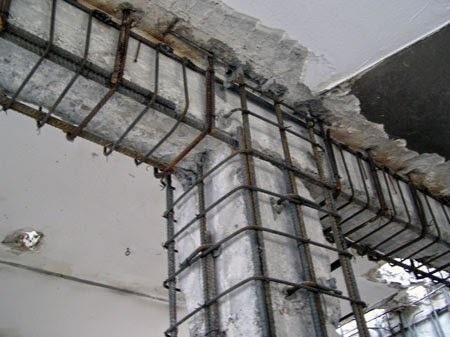This article explains the method of reinforcing concrete beams. Reinforcement of the reinforced concrete beam may be necessary if there are signs of rupture or excessive deformation.
An early sign of failure can be recognized by excessive deflection and flexural cracking of the beam. Such situations should be evaluated in consultation with a competent civil engineer.
Why do we need reinforcement of reinforced concrete beams
In general, concrete beam reinforcement is necessary when there is a risk of structural failure or when the bearing capacity of the structure needs to be improved, for example when beam loads increase.
Formation of flexural cracks in reinforced concrete beams
The beam may crack due to bending failure. This may be due to some of the issues discussed in the last part of this article. Unintentional increase in load on the beam, design errors, low compressive strength of concrete, wrong construction practices, etc. can cause cracks in the concrete beam due to insufficient structural strength.
Durability issues
The most important element that affects the useful life of a structure according to its design is its durability. Failure can have the following causes: Concrete rots, corrosion of reinforcements and other structural damage.
Carbonation, chloride attack and other factors can corrode reinforcement and reduce structural performance. If we talk about the durability of a structure, we also need to talk about the durability of concrete.
Increase the burden on the user
During or after construction, the load on the beams may increase due to changes in construction plans. In these cases, the load capacity of the beam can be evaluated if the quality of the concrete and the arrangement of the reinforcement are known. If the action caused by the load increases the load capacity of the beam, reinforcement must be carried out.
Low strength of concrete
Concrete may not have the required strength due to design or mixing problems, or due to errors in mixing the concrete. In these situations, we evaluate the load capacity of the column beam based on the available concrete strength. If this were not enough, we must reinforce support.
Concrete beam reinforcement method
If there are signs of failure in the beam, necessary precautions must be taken to prevent such failures. The beam needs additional support to prevent further deformation.
The following methods can be used to strengthen beams.
Increase beam depth and change size
In such cases, if there is a problem with the load capacity, the depth of the beam is increased. If the concrete of the beam is damaged, in addition to increasing the depth, we can also repair the side of the beam.
The following figure shows the method of fixing the reinforcement of a beam.


When reinforcing concrete beams, the following steps can be followed.
- First, the structural strength of the beam is evaluated. Based on this, the method of conveyor modernization is determined. As part of the beam modernization, the type of beam reinforcement method and other technical requirements such as diameter of the reinforcing bar, depth of the new beams, etc. are determined.
- If the beam is in good condition, the concrete surface may be sufficiently chipped. If we reinforce the damaged concrete beam, all damaged concrete must be removed. This must be done under the strict supervision and guidance of the civil engineer.
- We can add some rods to improve adhesion and prevent the new concrete from separating from the old.
- The booster can then be connected.
- If possible, the binding agent can be applied according to the supplier's instructions.
Steel Supports
Steel plates or steel profiles, such as beams or universal supports, are fixed under the beam to increase its load-bearing capacity. These types of modifications are usually made to a concrete beam that is in good condition. Implementing this strategy makes more sense when support loads increase as a result of additions to structures.
The following figure shows the beam reinforced with steel plates.


Conveyor FRP Lining
Fiber cloth reinforcement technology and fiber plate reinforcement technology are the two forms of FRP coating technology. It is an innovative technical support and recovery strategy. Resin bonding materials are generally used to attach fiber-reinforced polymer (FRP) to the surface of concrete and stressed parts of components to achieve reinforcement of the building structure.


High strength, low weight, faster construction time, etc. are advantages of this technology. Additionally, this method performs reinforcing operations on additional parts such as beams and slabs.

